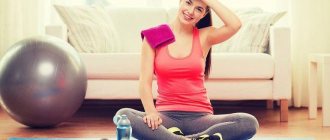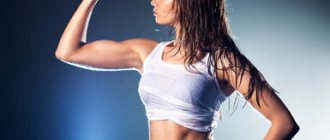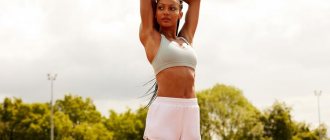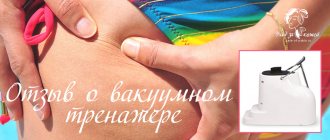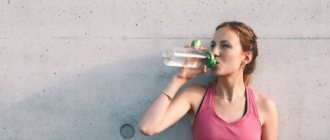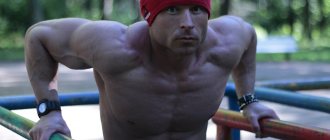What are the benefits of Pilates?
This discipline develops the body comprehensively. “Training develops conscious control of your body and coordination,” says Diana Ibragimova, trainer of the Fitness Territory network of clubs and author of the Instagram blog @di.fitt. - Thus, during training, not only the muscles work, but also the mind.
These are rehabilitative classes, so they are ideal for everyone, including beginners.” In terms of its impact on muscles, Pilates helps strengthen the core area. “And this is the key to safe movement in life and in training, as well as good posture. The muscles of the back and abdomen become strong and beautiful,” adds Diana Ibragimova.
Also, regular Pilates classes develop grace and smooth movements. “The effect of stretching and strengthening muscles. Together, this contributes to the balanced development of the body, strength and grace,” notes Diana Ibragimova.
Of course, all these bonuses can only be obtained if you practice according to the rules and perform the exercises correctly.
Why should you choose Pilates?
Pilates classes are a good way to keep fit and take care of the health of your spine (you can find out why here). But this, of course, is not the only advantage of the method. “One of its main differences from other workouts is the coordinated strengthening of the internal and superficial muscles of the body,” says Victoria Lill , master trainer at the Michael King Pilates International School, coordinator of educational programs at the FitLab Fitness Laboratory. “In addition, Pilates classes require continuity in work, which allows you to simultaneously strengthen and stretch your muscles. As a result, we get a strong, toned body, with defined muscles, but without excess volume, such as, for example, after strength training.”
Pilates for beginners: where to start?
Unlike other, more energetic types of exercise, Pilates involves smooth movement, a special type of breathing and maximum concentration on the work of the target muscles. This is exactly what beginners often have difficulty with.
Therefore, the first step in Pilates should be to master the basic rules of the discipline (such as breathing patterns) and change movement habits. “The main task for beginners in Pilates is to restore the correct movement patterns anatomically,” says Anastasia Yurkova, master trainer of the X-Fit group programs in Russia.
Most of us have certain postural disorders and movement patterns developed on their basis (most often incorrect). We slouch, “lean” to one side, and sleep in approximately the same position. Pilates classes allow you to master more correct movement patterns and improve posture. But when mastering them, it is important to avoid automatism; you need to “teach” the body to move according to new patterns.
This is what Pilates exercises for beginners are aimed at. “Beginners need exercises that allow them to normalize and restore the pattern of movement in all planes. We are required to perform movements lying on our backs, on our stomachs, and to the side - this way we use all the main joints and directions of movement,” explains Anastasia Yurkova.
It is also important for beginners to master the neutral position of the spine. “We all have postural disorders, there are some habits in the way we sit, lie, skewed to one side, in hyperlordosis or stoop,” says Anastasia Yurkova. “This is not the correct anatomical position; there is no need to move in it.” This is dangerous for the musculoskeletal system. The first step is to teach the body this neutral position.”
Among the exercises recommended for beginners, experts especially highlight lightweight versions of the classic movements of the discipline. “These include “pelvic clock”, “hundred”, shoulder bridge, one leg circles, one leg stretch, exercises lying on the side and on the stomach, back rolls, saw, roll up-roll down, “pendulum”, lists Diana Ibragimova.
What to try?
Pilates
One of the popular areas of “slow fitness” is Pilates. This is not just a set of movements, but a whole system built on a physiotherapeutic approach, says the expert. There are several types of this direction: on large equipment, on small equipment and on a mat (similar to a yoga mat). If big equipment intimidates you and you think only acrobats can do it, start with the Pilates Mat.
TRX exercises to strengthen your deep core muscles. Back health depends on them
What happens if you don't warm up before training?
Pilates classes range from simple to complex
There is no classical scheme in the form of a warm-up, main part and cool-down. Pilates involves retraining the body, so it has no contraindications.
Each exercise has several modifications to make everyone comfortable and, most importantly, safe. For example, the same movement can be adjusted to a person with osteoporosis, hypertension, or vertebral displacement. The activity is suitable even for pregnant women.
Pilates should not be perceived only as part of rehabilitation fitness. Thanks to proper body alignment, you will notice how:
- excess muscle tension goes away;
- beautiful and functional posture is formed;
- coordination improves;
- tissue elasticity increases;
- more energy appears.
Photo: istockphoto.com
Anna:
Pilates is suitable for those who, in pursuit of a beautiful body, want to maintain healthy and youthful joints. Here you will form an elastic body with soft muscle relief and get to know it in a new way.
Pilates: workout for beginners for 20 minutes
We asked Anastasia Yurkova to compose and show us a set of Pilates exercises for beginners. “These movements help to master the basics of Pilates,” says Anastasia Yurkova. “In the beginning, it is important to pay attention to learning the correct movement pattern, neutral posture, and breathing pattern.”
How to build a lesson
- Start your workout with a light warm-up.
- Perform the exercises sequentially at a slow pace. “I usually recommend performing each exercise 8-15 times, doing it slowly, so that at every moment of movement you are aware of the work of the muscles,” says Anastasia Yurkova. — Focus not on the quantity of movements, but on their quality. It’s better to make 5 movements, but high-quality ones. If on the sixth movement I feel that I’m already starting to help myself, to engage other muscles, then that’s it, I don’t do it anymore.”
- Do this program 3-4 times a week. “If you wish, you can do it more often, since the training is not too intense,” notes Anastasia Yurkova.
To complete the complex you only need a mat.
Simplified "hundred"
1-lying body raise
Lie on your back, bend your knees, place your feet on the floor. Place your fingers together at the back of your head and keep your lower back in a neutral position. Smoothly lift your shoulders, shoulder blades and the back of your head up, actively working your abdominal muscles. Relax your neck. Stay in this position for 10-15 seconds , then lower down.
Shoulder bridge
2-arm bridge
Lie on your back, bend your knees, place your feet on the floor. Stretch your arms along the body, rest on your shoulders, the back of your head, and your feet. Smoothly lift your pelvis above the floor, aligning your spine in one straight line and actively working your abdominal and buttock muscles. Then smoothly lower your pelvis and body down, laying vertebra by vertebra on the floor. Do not make sudden movements. This is one repetition, do 8-15 of these .
Lying crunches
3-lying crunches
Lie on the floor, bend your knees, place your feet on the floor. Stretch your arms to the sides, placing your palms on the floor. Turn your left knee to the side and place your left foot on your right knee. Maintain a neutral spine position. From here, slowly lower your right leg to the right, touching your thigh and left foot to the floor. Keep both shoulders pressed to the floor and move by twisting your thoracic spine. Then smoothly return to the starting position. This is one repetition, do 8-15 of these . Then do the same in the other direction.
"Rolls"
4-rolls lying down
Lie on your back, stretch your legs up, pressing your lower back to the floor. Place your hands behind your head. Smoothly twist your body forward, raising your shoulder blades above the floor, actively working your abdominal muscles. Then move your palms to your thigh muscles, smoothly round your spine, roll your body forward and sit down. Stretch your crown upward. Then smoothly round your back, “roll” backwards on your pelvic bones and lower your spine to the floor. Raise your legs up, put your hands behind your head again. This is one repetition, do 8-15 of these .
Arm rotation while lying on your side
5-rotation in the thoracic region
Lie on your right side, place your right arm behind your head, bend your knees slightly. Keep your lower back neutral and your abdominal muscles slightly toned. Extend your left arm upward and move it in a wide circle back, opening your chest. This is one repetition, do 8-15 of these in each direction. Don't slouch, don't lean your body forward or backward.
"Swan"
6-swan
Lie on your stomach with your arms extended in front of you. Pull the toes of your feet away from you. Maintain a neutral position in your lower back while actively working your abdominal and back muscles. Stretch your neck, direct your gaze to the floor. Smoothly lift your right arm and left leg above the floor. Then lower them and raise your left arm and right leg. This is one repetition, do 8-15 of these. Don't arch your lower back or slouch.
Lifting the body
7-body lift
Lie on your stomach with your arms in front of you, elbows slightly bent and resting on your forearms. Place your forehead on the floor. Pull the toes of your feet away from you. Maintain a neutral position in your lower back while actively working your abdominal and back muscles. Smoothly lift your head above the floor, then your neck, shoulders and upper back. Then just as smoothly and consistently lower the body to the floor. This is one repetition, do 8-15 of these.
"Wave"
8-wave
Get down on your knees and place your shins on the floor. Place your palms under your shoulders. Then lower your pelvis onto your heels, extend your arms, press your stomach to your thighs. Then smoothly move your body forward, pushing up your lower back and thoracic spine, and at the extreme point of the movement, pull your shoulder blades up. Smoothly return to the starting position. This is one repetition, do 8-15 of these.
At first it may be difficult for you to move slowly and engage the target muscles, but after three or four sessions everything will work out.
However, mistakes that beginners usually make can disrupt the effectiveness of these exercises.
Types of Pilates classes
There are several varieties of this trend; they can be divided into two groups: traditional (created by Joseph Pilates) and modern (all kinds of fitness hybrids). Each of them is suitable for both those who have already tried Pilates and beginners. “In any of the categories of Pilates there are basic exercises that we usually recommend to beginners so that they can get acquainted with the main principles of the classes and feel the work of the muscles of the center,” says Victoria Lill.
The goals of traditional and modern movements are often similar: regular exercise improves posture, strengthens the muscle corset, helps reduce muscle imbalances (caused, for example, by scoliosis) and become slimmer. “But you shouldn’t hope that just doing Pilates twice a week will save you from 20 extra pounds,” reminds Victoria Lill. — A balanced diet plays a major role in this process. If, while doing Pilates, you adjust your diet and add regular cardio exercise (with your heart rate in the fat-burning zone), you can noticeably lose weight. In other cases, you shouldn’t expect a miracle.”
Traditional types include :
* Work on the mat (or Pilates Matwork). It is further divided into two subspecies:
– Bodyweight workouts, for which, of course, you don’t need anything other than a mat. Exercises in this category do not have an axial load and are aimed primarily at strengthening the internal and superficial muscles of the abdomen and back (which is why they are often recommended for those who have problems with the spine).
Choose these classes if: you like relaxing activities, you would like to train not only in a fitness club, but also at home, your goal is to improve your spinal health and posture.
– Training with small equipment (large and small ball, isotonic ring, rigid roller), which helps to complicate or simplify traditional exercises, select the desired modification, or simply better understand the meaning of a particular Pilates exercise.
Choose these classes if: you already have experience with Pilates, you would like to train at home or in a fitness club, your main goal is to strengthen and stretch muscles in a coordinated manner, as well as develop spinal flexibility.
* Work on simulators , for which special equipment is used - a reformer, a Cadillac, a spinal corrector, etc. Their main difference from other fitness units is their versatility and the absence of axial load. Such exercises allow you to use internal and superficial muscles, develop strength, flexibility, joint mobility, and get rid of back pain.
Choose these classes if: you are already somewhat familiar with the Pilates method and are ready to practice in a studio. “In addition to the fact that Pilates machines are difficult to place in an ordinary apartment, there is another difficulty: it is impossible to master their correct use without professional help,” says Victoria Lill.
Modern types of Pilates are:
* Aquapilates - Pilates classes in water. Their main advantage is almost the same as that of water aerobics: exercise in water helps you burn more calories than on land.
Choose these classes if: you want to work out in a fitness club, you love water workouts, you have or do not have back pain, you have mastered the basic principles of Pilates “on land”.
* Yogalates is a hybrid of yoga and Pilates that combines the dynamism of the ancient practice and the work of deep muscles.
Choose these classes if: you are already familiar with both yoga and Pilates, and just want to try something new and equally effective.
* Cardiolates - Pilates classes in cardio mode. “In these classes, classical Pilates exercises are performed at a high tempo. They are often marketed as workouts for weight loss,” explains Victoria Lill. Choose these classes if: you want to lose weight and are not ready to go to a classic gym (don’t forget about nutritional correction), you like energetic activities.
* Piloxing is a mix of Pilates and kickboxing. Classes are held at a high pace, many exercises are performed in a fighting stance (which requires constant work of the core muscles).
Choose these classes if: you like energetic activities, you are ready for high loads, you would like to exercise at home or in a fitness club, you do not have problems with your joints.
General concept
Pilates training was originally carried out for the purpose of rehabilitation of the wounded. It is for people for whom active exercise is contraindicated that a special set of exercises was developed, named after its creator. It was noticed that with regular exercise, all body functions are normalized, skin is tightened and fat is burned. This type of fitness is aimed at strengthening muscles. He combined the elements:
- stretching;
- yoga;
- body ballet;
- aerobics
The secret to effectiveness is breathing.
All exercises are performed thoughtfully and slowly. People of all ages and any level of physical fitness are allowed to take part in the classes. There are developed programs for beginners and professionals. This sport has virtually no contraindications. Gym
Pilates studio
Aerobic programs
A way to combat excess weight
Experts recommend doing Pilates for those who want to get rid of 15 or more extra pounds. This is due to the fact that as a result of training, fats are burned slowly, without causing harm to health. It has been observed that even 10 minutes of daily exercise can help you lose weight. The secret is simple. The complex is developed in such a way that during training
- muscles tightened:
- press;
- hips;
- chest.
As you know, these are the most problematic areas on the women’s body, and taking them into account, the trainer selects the desired program. It seems simple. Athletes bend over, tense their abs, and remain in certain positions for the required number of seconds. The number of approaches is usually determined individually. Having achieved the desired result, you do not need to stop exercising. This will help keep you in shape, improve your well-being and mood. Don’t forget that you not only need to do gymnastics, but also eat right. Any experienced trainer can give recommendations on this issue.
